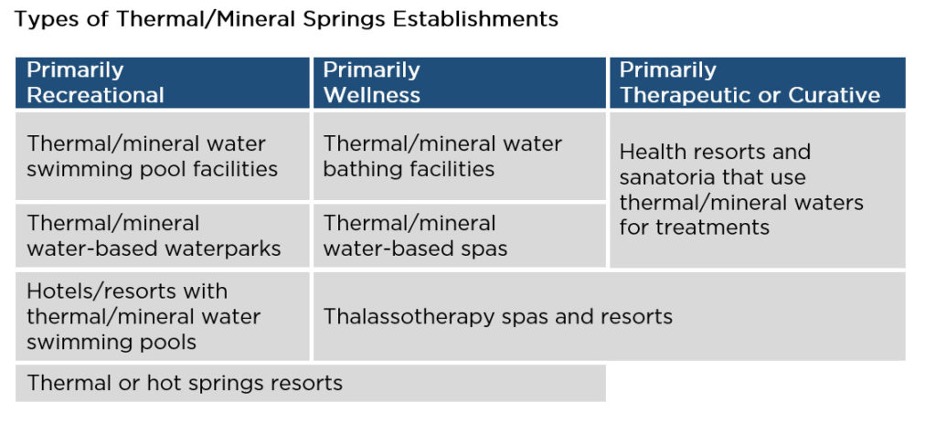THERMAL/MINERAL SPRINGS
The Global Wellness Institute has tracked and measured the global thermal/mineral springs industry for more than a decade. In 2013, we estimated that thermal/mineral springs was a $50 billion industry globally. Since that time, the thermal/mineral springs industry has grown rapidly alongside the broader wellness movement. As of 2023, we estimate 31,200 thermal/mineral springs establishments operating worldwide, earning $63 billion in revenues. Growth will continue to accelerate in the coming years with rising consumer interest and business investment in the sector all around the world.
The majority of thermal/mineral establishments around the world are rustic and traditional bathing and swimming facilities. They target their local markets and charge relatively low admission fees. About a quarter of the establishments are higher end, targeting tourists and offering value-added spa services. Those that offer spa services account for a much greater share of industry revenues (over two-thirds) and have also experienced higher revenue growth historically.
The thermal/mineral springs industry is heavily concentrated in Asia-Pacific and Europe, reflecting the centuries-old history of water-based healing and relaxation in these two regions. Together, Asia-Pacific and Europe typically account for about 95% of the total global establishments and revenues each year.
Thermal/mineral springs bathing experiences appeal to a growing segment of consumers seeking to connect with nature; experience cultural traditions; and pursue alternative modalities for healing, rehabilitation, and prevention. Responding to these trends, both private investors and governments across many countries are investing in the sector. In countries with long-established thermal bathing traditions, governments are increasingly promoting these as a key wellness tourism offering. They are investing in renovation and reopening of primitive, outdated, and closed-down facilities, as well as upgrading service standards and training to meet the expectations of international tourists. An estimated 350 new thermal/mineral springs projects have opened worldwide in 2020-2024, and over 230 more projects are in the pipeline for future openings/development.
Thermal/Mineral Springs Defined:
GWI defines the thermal/mineral springs industry as encompassing revenue-earning business establishments associated with the wellness, recreational and therapeutic uses of waters with special properties. GWI’s figures count thermal/mineral springs establishments that operate as a business, and as such, do not include springs that do not have any built facilities and/or do not charge any kind of fee for access. Establishments that use heated water—not naturally sourced thermal/mineral water—are also excluded from this category. There are many categories and types of thermal/mineral springs establishments, as illustrated below:

Our revenue estimates include all revenues earned by the establishments in the above categories (not just revenues from thermal/mineral-water bathing and treatments). Therefore, our estimates include revenues earned from bathing/swimming offerings, spa/wellness services and other treatments, other recreational activities, food and beverage, lodging, and other services offered by the establishment.
For more information:
- GWI’s thermal/mineral springs figures are updated and released every few years in the Global Wellness Economy Monitor. For the most recent data and research, see Wellness Economy Data Series.
- Additional information and resources are available through GWI’s Hot Springs Initiative.
























































